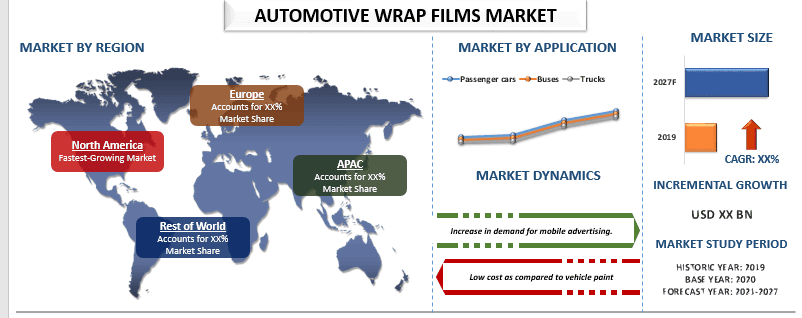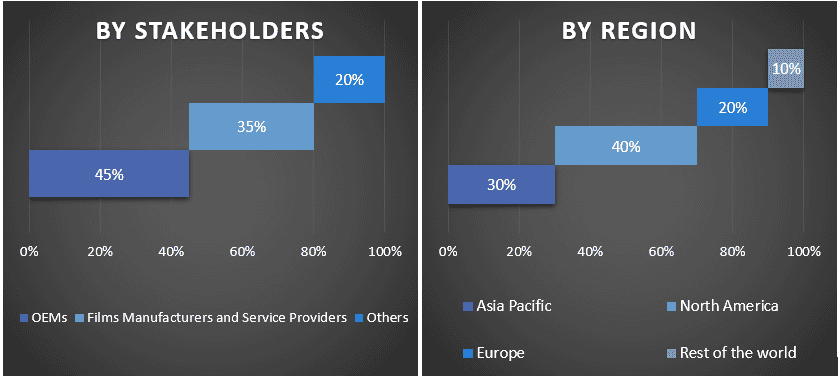- Inicio
- Acerca de nosotros
- Industria
- Servicios
- Leyendo
- Contáctenos
Mercado de Películas Adhesivas para Automóviles: Análisis Actual y Pronóstico (2021-2027)
Énfasis en la Aplicación (Turismos, Autobuses y Camiones); Región/País

SOLICITAR PDF DE MUESTRA GRATUITA
Los revestimientos para automóviles son cada vez más importantes para la salud del vehículo y la seguridad del pasajero a largo plazo. Los revestimientos de película para automóviles se utilizan a menudo con fines de marketing, ya que son relativamente más baratos que otros métodos de publicidad.Por ejemplo, según un informe de Big Picture Graphics, un revestimiento de vehículo puede generar entre 30.000 y 80.000 impresiones diarias.Además, la expansión continua en los mercados de automóviles de segunda mano también ha resultado en un aumento en la demanda de películas adhesivas, ya que los arañazos significativos, la pintura defectuosa y otras imperfecciones pueden ocultarse con el uso de películas adhesivas.
Se espera que el mercado global de películas adhesivas para automóviles registre una CAGR de alrededor del 22% durante el período 2021-2027.
Una película adhesiva para automóviles es un diseño de vinilo que se coloca directamente sobre la pintura original del vehículo. Estas películas se aplican típicamente con dos propósitos: alterar o mejorar la estética de un vehículo y mantener la pintura original de la suciedad y el óxido.
Algunos de los principales actores que operan en el mercado incluyen 3M Company, Ads Window Films Limited, Arlon Graphics LLC, Avery Dennison Corporation, Eastman Chemical Company, Foliatec Bohm Gmbh & Co. Vertriebs Kg, Garware Polyester Limited, Hexis S.A., Kay Premium Marking Films Ltd y Madico, Inc.
Información Presentada en el Informe
“Entre las aplicaciones, se espera que el segmento de turismos sea testigo de la CAGR más alta durante el período de pronóstico”
Según la aplicación, el mercado se clasifica en turismos, autobuses y camiones. La categoría de turismos tiene una cuota de mercado significativa, lo que se debe principalmente a los precios más bajos de los revestimientos para automóviles y a la mayor preferencia del cliente por la personalización del vehículo, como diferentes colores y texturas. Además, la logística y el desarrollo en curso en países en desarrollo como China probablemente impulsarán el crecimiento en los sectores de autobuses y camiones durante el período de proyección. Estos factores contribuyen al sector de mercado de comerciales en camiones y autobuses durante el período de tiempo proyectado.
“Se espera que América del Norte sea testigo de un crecimiento significativo durante el período de pronóstico”
América del Norte ha representado una CAGR significativa en los últimos años. La industrialización temprana, junto con el mayor uso de vehículos para campañas publicitarias en la región, ha resultado en una fuerte demanda para el negocio de películas adhesivas para automóviles. Además, se proyecta que la expansión del mercado durante el período anticipado sea impulsada por el bajo costo de las películas adhesivas en comparación con la pintura y el creciente interés de los clientes en la personalización de sus automóviles en la región de América del Norte.
Razones para comprar este informe:
- El estudio incluye el dimensionamiento del mercado y el análisis de pronóstico validado por expertos clave de la industria autenticados.
- El informe presenta una revisión rápida del rendimiento general de la industria de un vistazo.
- El informe cubre un análisis en profundidad de los pares de la industria prominentes con un enfoque principal en las finanzas comerciales clave, la cartera de productos, las estrategias de expansión y los desarrollos recientes.
- Examen detallado de los impulsores, las restricciones, las tendencias clave y las oportunidades que prevalecen en la industria.
- El estudio cubre exhaustivamente el mercado en diferentes segmentos.
- Análisis en profundidad a nivel regional de la industria.
Opciones de Personalización:
El mercado global de películas adhesivas para automóviles se puede personalizar aún más según el requisito o cualquier otro segmento del mercado. Además de esto, UMI entiende que puede tener sus propias necesidades comerciales, por lo tanto, no dude en conectarse con nosotros para obtener un informe que se adapte completamente a sus requisitos.
Tabla de contenido
Metodología de Investigación para el Análisis del Mercado Global de Películas Adhesivas para Automóviles (2021-2027)
Analizar el mercado histórico, estimar el mercado actual y pronosticar el mercado futuro del mercado global de películas adhesivas para automóviles fueron los tres pasos principales realizados para crear y analizar la adopción de películas adhesivas para automóviles en las principales regiones a nivel mundial. Se realizó una extensa investigación secundaria para recopilar los números históricos del mercado y estimar el tamaño actual del mercado. En segundo lugar, para validar estos conocimientos, se tomaron en consideración numerosos hallazgos y supuestos. Además, también se realizaron exhaustivas entrevistas primarias con expertos de la industria en toda la cadena de valor del mercado global de películas adhesivas para automóviles. Tras la asunción y validación de los números de mercado a través de entrevistas primarias, empleamos un enfoque de arriba hacia abajo/abajo hacia arriba para pronosticar el tamaño completo del mercado. Posteriormente, se adoptaron métodos de desglose del mercado y triangulación de datos para estimar y analizar el tamaño del mercado de los segmentos y subsegmentos de la industria en cuestión. La metodología detallada se explica a continuación:
Busque más detalles sobre la metodología de investigación
Análisis del tamaño histórico del mercado
Paso 1: Estudio en profundidad de fuentes secundarias:
Se realizó un estudio secundario detallado para obtener el tamaño histórico del mercado del mercado de películas adhesivas para automóviles a través de fuentes internas de la empresa, comoinformes anuales y estados financieros, presentaciones de rendimiento, comunicados de prensa, etc.,y fuentes externas incluyendorevistas, noticias y artículos, publicaciones gubernamentales, publicaciones de la competencia, informes sectoriales, bases de datos de terceros y otras publicaciones creíbles.
Paso 2: Segmentación del mercado:
Después de obtener el tamaño histórico del mercado del mercado de películas adhesivas para automóviles, realizamos un análisis secundario detallado para recopilar información histórica del mercado y compartir para diferentes segmentos y subsegmentos para las principales regiones. El segmento principal está incluido en el informe, como la aplicación. Además, se realizaron análisis a nivel de país para evaluar la adopción general de modelos de prueba en esa región.
Paso 3: Análisis de factores:
Después de adquirir el tamaño histórico del mercado de diferentes segmentos y subsegmentos, realizamos unanálisis de factoresdetallado para estimar el tamaño actual del mercado del mercado de películas adhesivas para automóviles. Además, realizamos un análisis de factores utilizando variables dependientes e independientes, como las aplicaciones de películas adhesivas para automóviles. Se realizó un análisis exhaustivo de los escenarios de la oferta y la demanda, considerando las principales asociaciones, fusiones y adquisiciones, la expansión comercial y los lanzamientos de productos en el sector del mercado de películas adhesivas para automóviles en todo el mundo.
Estimación y pronóstico del tamaño actual del mercado
Dimensionamiento actual del mercado:Basándonos en la información procesable de los 3 pasos anteriores, llegamos al tamaño actual del mercado, a los actores clave en el mercado global de películas adhesivas para automóviles y a las cuotas de mercado de los segmentos. Todas las cuotas porcentuales requeridas divididas y los desglose del mercado se determinaron utilizando el enfoque secundario antes mencionado y se verificaron a través de entrevistas primarias.
Estimación y pronóstico:Para la estimación y el pronóstico del mercado, se asignaron ponderaciones a diferentes factores, incluidos los impulsores y las tendencias, las restricciones y las oportunidades disponibles para las partes interesadas. Después de analizar estos factores, se aplicaron técnicas de pronóstico relevantes, es decir, el enfoque de arriba hacia abajo/abajo hacia arriba, para llegar al pronóstico del mercado alrededor de 2027 para diferentes segmentos y subsegmentos en los principales mercados a nivel mundial. La metodología de investigación adoptada para estimar el tamaño del mercado abarca:
- El tamaño del mercado de la industria, en términos de ingresos (USD) y la tasa de adopción del mercado de películas de rotulación automotriz en los principales mercados a nivel nacional
- Todas las cuotas porcentuales, divisiones y desgloses de segmentos y subsegmentos del mercado
- Actores clave en el mercado global de películas de rotulación automotriz en términos de soluciones ofrecidas. Además, las estrategias de crecimiento adoptadas por estos actores para competir en el mercado de rápido crecimiento
Validación del Tamaño y la Cuota de Mercado
Investigación Primaria:Se realizaron entrevistas en profundidad con los Líderes de Opinión Clave (KOL, por sus siglas en inglés), incluidos los Ejecutivos de Alto Nivel (CXO/VPs, Jefe de Ventas, Jefe de Marketing, Jefe de Operaciones, Jefe Regional, Jefe de País, etc.) en las principales regiones. Los hallazgos de la investigación primaria se resumieron y se realizó un análisis estadístico para probar la hipótesis establecida. Los datos de la investigación primaria se consolidaron con los hallazgos secundarios, convirtiendo así la información en conocimientos prácticos.
División de los Participantes Primarios en Diferentes Regiones

Ingeniería de Mercado
Se empleó la técnica de triangulación de datos para completar la estimación general del mercado y llegar a números estadísticos precisos para cada segmento y subsegmento del mercado global de películas de rotulación automotriz. Los datos se dividieron en varios segmentos y subsegmentos después de estudiar varios parámetros y tendencias en las áreas de oferta y técnica en el mercado global de películas de rotulación automotriz.
El objetivo principal del Estudio de Mercado Global de Películas de Rotulación Automotriz
En el estudio se identificaron las tendencias actuales y futuras del mercado global de películas de rotulación automotriz. Los inversores pueden obtener información estratégica para basar su discreción para las inversiones en el análisis cualitativo y cuantitativo realizado en el estudio. Las tendencias actuales y futuras del mercado determinaron el atractivo general del mercado a nivel regional, proporcionando una plataforma para que el participante industrial explote el mercado sin explotar para beneficiarse como una ventaja del primer motor. Otros objetivos cuantitativos de los estudios incluyen:
- Analizar el tamaño actual y previsto del mercado de películas de rotulación automotriz en términos de valor (USD). Además, analizar el tamaño actual y previsto del mercado de diferentes segmentos y subsegmentos
- Los segmentos en el estudio incluyen áreas de aplicación y región.
- Definición y análisis del marco regulatorio para la industria del mercado de películas de rotulación automotriz.
- Analizar la cadena de valor involucrada con la presencia de varios intermediarios, junto con el análisis de los comportamientos de los clientes y competidores de la industria.
- Analizar el tamaño actual y previsto del mercado de películas de rotulación automotriz para la región principal.
- Los principales países de las regiones estudiadas en el informe incluyen Asia Pacífico, Europa, América del Norte y el Resto del Mundo.
- Perfiles de empresas del mercado de películas de rotulación automotriz y las estrategias de crecimiento adoptadas por los actores del mercado para sostenerse en el mercado de rápido crecimiento
- Análisis a nivel regional en profundidad de la industria
Relacionados Informes
Los clientes que compraron este artículo también compraron










